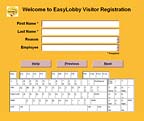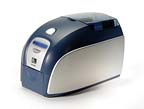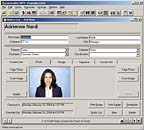Closing the Card Chasm

Manufacturer International Truck and Engine, Inc., Warrenville, Ill., had an even more primitive method: the written log. “Most of our facilities are access-badge only,” says Mike Scribner, technical support and development, corporate security. “Yet the old way [to do visitor security] was hand-written logs and maybe sometimes they would write out a badge they would stick on themselves.”
Both PTC and International Truck and Engine felt the need to improve visitor security and both chose an automated visitor management system (EasyLobby, Needham, Mass.).

Software updates
As a software company, O’Brien felt his firm should be up-to-date on technology in their visitor security as well.“We do a large customer base, so we get a lot of customers coming in to get demos on software and learn how to use it,” O’Brien says. “I thought a visitor management program would be ideal.
“I had looked at a few other systems, but I felt that EasyLobby was the most user-friendly.”
The visitor badging system integrated with PTC’s access control system, allowing security to design its own visitor badges to fit any need. For example, there are regular visitor ID badges and corporate visitor ID badges, with a different design. “We have CEOs of other companies visiting,” O’Brien says. “It’s more official looking.”
While it is a capability of the system, PTC doesn’t incorporate pictures on its visitor badges. “We have so many groups that come in 40 at a time,” he says. “It would be nearly impossible.” However, they do have an e-mail set-up that goes right to the desk, so they can print badges ahead of time for larger groups. “We can have a bunch of already printed out badges and just hand them out. If someone is not on the list it takes 30 seconds to make one.”

Revamping visitor policies
At International Truck and Engine, the EasyLobby system was part of an overall effort to improve visitor security.“We had a need to improve the way we handle visitor management,” Scribner says. “What we wanted to do was make sure all our visitors were properly identified and properly badged. We wanted to make it so any individual walking around the facility, it would be easy to see they had been identified through reception or security.
“A program like (this) makes professional-looking badges and also stores all the visitor information in a database,” Scribner says.
The company had installed EasyLobby at its headquarters in 2001. So when they decided to take the technology company-wide, it was one of the top choices. “We narrowed our search to two companies,” Scribner says. “We test drove each at two of our larger facilities.” In the end, EasyLobby won. “It just fit into our infrastructure,” Scribner says. “The price point was right and it had all the functionality we required.”

Both companies have plans to expand their systems. At International Truck and Engine, there are 20 EasyLobby stations in 16 facilities. “Our designation was that any facility with 100 or more employees we wanted EasyLobby installed,” Scribner says.
Expansion is mainly international, he adds. “Right now we have it in most of the U.S. and one in Canada. We are putting one more in Canada, and we want to roll out to Mexico and eventually into South America. We’re pretty much done with the U.S. Our expansion efforts now are foreign.”
At PTC, the system is due to be installed in two offices in the U.K., as well as two U.S. locations. “I’m moving to put an EasyLobby system in every office with a training facility,” O’Brien says. The training rooms all use card access, he explains. For PTC there will eventually be about 10 locations that have the system.
Both Scribner and O’Brien feel the technology has improved visitor security at their facilities immensely.
Another benefit, Scribner says, is emergency management. “If we have an emergency, at any time we can electronically see, through the EasyLobby system, exactly which visitors are on the premises.”
O’Brien, too, believes visitor security is better served with the technology. “I liked the whole tech thing. We are a technology company and I felt we should move on through technology. Now we are able to track visitors better and not leave a drawer full of active cards lying around. That’s a security benefit right there.”
Smart cards & platform standards
There are emerging smart card options for consistent visitors. The challenge here – standards. Smart card organizations, enterprise end-users and governments need to work together in developing global standards for smart card and identification applications. Further, open platforms, due to their scalability and security features, will have to evolve as strong foundations for the credible execution of such vital applications. In addition, Palo Alto, Calif.-based Frost & Sullivan (World Battle of Platforms) says that unit shipments for open platform cards totaled 400 million in 2004 and 1.15 billion by 2011.Open platforms such as Java Card and MULTOS are for dynamic, secure and multi-application smart card applications. These technologies provide the option of upgrading the cards with minimal efforts and without incurring additional costs or having to replace the card.
In an attempt to break into the lower end, fixed functions markets, Java Card and MULTOS have introduced the Java Card S program and the Step/one program, respectively. While the Java Card S program does not accommodate dynamic downloading capabilities, it does allow for interoperability with full function Java Cards that the issuer may launch at a later stage.
Government ID projects are key for open platform cards; there is a shift to contactless and dual interface cards. Nevertheless, the majority of contactless cards in banking applications remains with native platforms.
Looking for a reprint of this article?
From high-res PDFs to custom plaques, order your copy today!







